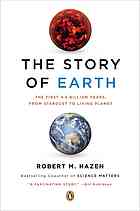
The Story of Earth
The First 4.5 Billion Years, from Stardust to Living Planet
کتاب های مرتبط
- اطلاعات
- نقد و بررسی
- دیدگاه کاربران
نقد و بررسی

February 6, 2012
With a blend of storytelling and science (from mineralogy and geology to biochemistry), Hazen (Science Matters) illuminates the origins of Earth and the origins of life. Hazen begins some 4.5 billion years ago, when the solar system coalesced from a cloud of cosmic debris. Hazen, a professor of earth science at George Mason University, describes the “Big Thwack” from a wandering asteroid that knocked off a piece of molten Earth to make the Moon. The creation of oceans and continents fed by Earth’s “inner heat”; a celebrated 1953 experiment to recreate the Earth’s “primordial soup”; and the discovery of strange creatures living on volcanic vents deep underwater show that life probably began in the water. Hazen moves on to photosynthetic organisms and their impact on the atmosphere, and on the explosive growth of algae in shallow coastal waters. Fossils show that the first primitive animal life evolved at least 545 million years ago and endured despite the threats of natural disaster, mass extinctions, and the extreme cold of the Ice Ages. Hazen enriches his story with details about pioneering researchers like continental drift theorist Alfred Wegener, and his own experiences hunting for meteorites, handling moon rocks, and collecting trilobytes. This is a thoroughly accessible book, deftly mixing a variety of scientific disciplines to tell an unforgettable story. Agent: Eric Lupfer, William Morris Enterprises.

February 15, 2012
Hazen (Earth Science/George Mason Univ.; Genesis: The Scientific Quest for Life's Origins, 2005, etc.) offers startling evidence that "Earth's living and nonliving spheres" have co-evolved over the past four billion years. To support his persuasive though controversial views, the author updates evidence collected by mineralogists over the last two centuries. Describing the "discoveries of organisms in places long considered inhospitable [to life] - in superheated volcanic vents, acidic pools, Arctic ice and stratospheric dust," he argues for the dating of the origin of life more than a billion years earlier than estimates based on Nobel Prize winner Harold Urey's groundbreaking experiments. These appeared to support the view that life originated 2.5 billion years ago in an oceanic environment with the creation of organic molecules. Hazen explains how Urey and his associates were able to re-create "primordial soup" in a simulation, which produced "a suite of biomolecules stunningly similar to what life actually uses." That theory has been challenged in the last two decades, based on the discovery that life "fueled by chemical [rather than solar] energy" exists in extreme environments in astonishing abundance. Hazen and colleagues at the Carnegie Institution's Geophysical Laboratory (with support from NASA) have succeeded in simulating conditions that would have existed on Earth as early as 4.5 billion years ago, while producing biomolecules that are today the building blocks of life. The author situates this latest experimental evidence in a series of discoveries about the earth's geological evolution, sparked by analysis of moon rocks brought back by Apollo astronauts. A report of a fascinating new theory on the Earth's origins written in a sparkling style with many personal touches.
COPYRIGHT(2012) Kirkus Reviews, ALL RIGHTS RESERVED.

April 1, 2012
Hazen (senior research scientist, Carnegie Inst.; earth science, George Mason Univ.; Genesis: The Scientific Quest for Life's Origin) here describes mineral evolution--a sequence of mineral formation common to terrestrial planets. In later stages of this sequence, living organisms contribute to the formation of novel crystalline substances, while minerals make possible the evolution of new life forms; for example, Earth's first photosynthetic bacteria released oxygen into their watery surroundings and the atmosphere above, making possible new chemical reactions that produced a variety of oxygen-rich minerals. Some new minerals, in turn, provided sources of chemical energy that new life forms could exploit. Hazen is confident that life and minerals will continue to interact for millions of years, but he cautions that both natural geologic processes and human activity will probably jeopardize the survival of our own species. VERDICT While some overlap with the author's previous work is inevitable, this title is considerably more focused on geological history. Hazen has a gift for explaining science in lay terms, and even readers with a minimal understanding of geology, chemistry, and physics will find this book riveting.--Nancy R. Curtis, Univ. of Maine Lib., Orono
Copyright 2012 Library Journal, LLC Used with permission.

April 15, 2012
As an earth-sciences professor at George Mason University and the author of several previous popular-science books, including (with coauthor James Trefil) the best-selling Science Matters (2009), Hazen is the perfect candidate to pen this exceptionally readable layperson's guide to the earth's geological and biological history. Setting aside the usual geologic-era names such as Precambrian or Paleozoic, Hazen instead gives these periods more user-friendly labels like The Big Thwack, covering the moon's formation, and The Boring Billion, covering a span when terrestrial changes were relatively static. In describing the broad sweep of mineralogical and chemical alterations the earth underwent, from the appearance of the oceans to the emergence of primitive cellular life, Hazen demonstrates how minerals and living creatures have evolved together. This coevolution of life and rocks scenario represents a recent paradigm shift in geological science that, Hazen argues, merits closer study as the planet bears the brunt of human-caused climate change. Science junkies and readers interested in the environment will find Hazen's arguments compelling and his overview of earth's tumultuous history captivating.(Reprinted with permission of Booklist, copyright 2012, American Library Association.)

























دیدگاه کاربران